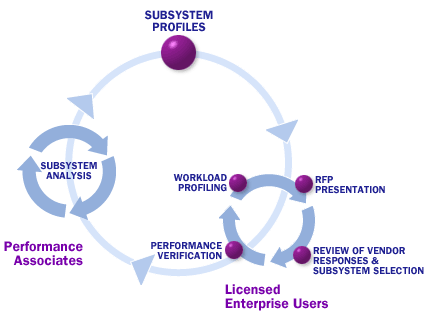

Perhaps the most common questions that our prospective customers ask us are “What is the PAI/O Driver?”, “Is it just a software product?”, and “How can my shop use PAI/O Driver in the storage acquisition process?”
What is the PAI/O Driver?
The PAI/O Driver is a vendor and technology independent set of tools and services for evaluating the performance characteristics of storage subsystems. The host software test component is employed by licensed enterprise users and site licensed storage subsystem vendors worldwide, and is used to evaluate storage subsystems. Our licensed enterprise users receive an extensive set of software tools, an acquisition methodology, subsystem profiles, profiling software, and a number of other services. Our vendor site licenses are restricted to just the host test component of PAI/O Driver. This restriction helps us maintain our vendor independence and prevents subsets of the PAI/O Driver profiles from being employed for marketing purposes.
The PAI/O Driver process is detailed in the figure shown above. The small ring towards the left of the figure depicts the Performance Associates storage subsystem testing process, the small ring towards the right depicts the user process, and the larger center ring depicts the delivery of subsystem profiles to our licensed enterprise users.
Is PAI/O Driver just a software product?
PAI/O Driver is not just a software product. As part of the user enterprise license process, Performance Associates has an ongoing commitment to analyze new and updated vendor storage subsystem offerings. Based on the results of our standard suite of engineering tests, Performance Associates prepares and distributes a performance profile of each new and updated vendor storage subsystem. The results of these tests can then be compared and contrasted with the results for any other storage subsystem that was profiled by PAI/O Driver. Each profile provides an independent and authoritative analysis of the subsystem architecture, a comprehensive and detailed discussion of the subsystem’s performance characteristics, and recommendations relative to negotiation points that we recommend be employed during the contracting process.
While there are other organizations that provide information that may initially sound similar to the PAI/O Driver storage subsystem profiles, their observations are based on vendor supplied performance data, anecdotal observations, or are just reformatted vendor brochures. Performance Associates is the only source for subsystem profiles that are based on rigorous independent testing and analysis.
The PAI/O Driver storage subsystem profiles are distributed to our licensed enterprise users. These profiles provide our clients an information resource for their storage acquisition process as is depicted by the large center ring of the PAI/O Driver process figure. Quite often, licensed users schedule conference calls with Performance Associates to discuss the contents of new profiles that are of particular interest to their enterprise.
How can my shop use PAI/O Driver in the storage acquisition process?
You can use PAI/O Driver in the storage acquisition process. The licensed enterprise user process is shown in the ring at the right of the figure. The first step in the storage acquisition process is to characterize storage subsystem requirements. As a licensed enterprise user, you will receive workload profiling software which analyzes your SMF data to determine your installation’s storage subsystem requirements in terms of access density, data transfer, access pattern (i.e., random or sequential), blocksize distribution, and locality of reference. This analysis provides a detailed description of your installation’s storage subsystem requirements, which in turn can be provided to potential vendors during a request for proposal (RFP) or other bid processes. As a licensed enterprise user you also receive a recommended acquisition methodology that assists you in incorporating enforceable performance warranties in acquisition contracts.
Once provided with your requirements, the storage subsystem vendors are then free to propose configurations that they warrant will meet your installation’s needs. Rather than you being responsible for specifying key storage subsystem features like cache size, the burden of configuring a storage subsystem(s) that will meet your installation’s needs is placed on the vendor. Each vendor could then provide responses to the RFP, and you can, in turn, evaluate these responses in terms of your acquisition criteria.
The PAI/O Driver storage subsystem performance profiles provide a basis for evaluating the vendor responses. Specifically, the proposed configurations and claimed performance for your workload can be compared with the information contained in the performance profiles. The critical difference of a storage subsystem acquisition based on the PAI/O Driver process is that you are provided with the ability to select the minimum priced storage subsystem which is guaranteed by the vendor to meet your requirements, not just the lowest cost per megabyte supported by only the vendor’s ambiguous performance claims!
The final step in the acquisition process is performance verification. Using the workload description that was created during the profiling process, the PAI/O Driver can be employed to perform an acceptance test of your new storage subsystem to verify that the system meets or exceeds the performance warranty provided by the vendor. If the subsystem passes the test, it can be introduced into the enterprise’s storage environment. Should it fail the verification test, then the enterprise has the recourse predefined in the acquisition agreement, as well as the ability to retest the subsystem after the vendor has corrected the performance deficiency.
Summary
This is the PAI/O Driver process. The PAI/O Driver is an independent and respected storage subsystem performance evaluation tool that is employed by user enterprises and vendors on a worldwide basis. For licensed enterprise users, it provides the only source of independent comparative performance data that is based on actual testing, not just conjecture or anecdotal observations. Finally, it provides licensed enterprise users a methodology and a tool set for conducting storage subsystem acquisitions that incorporate enforceable performance warranties.